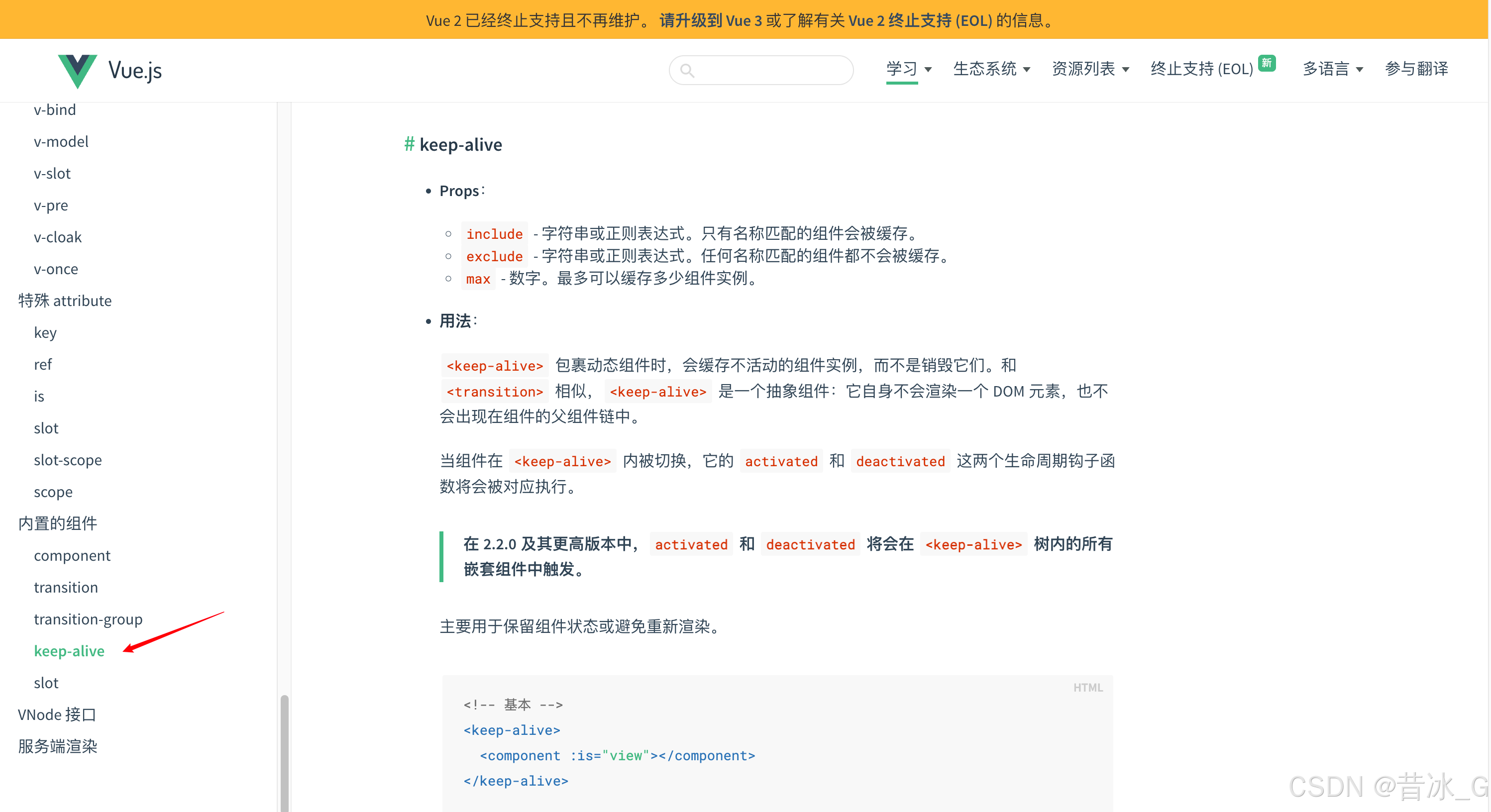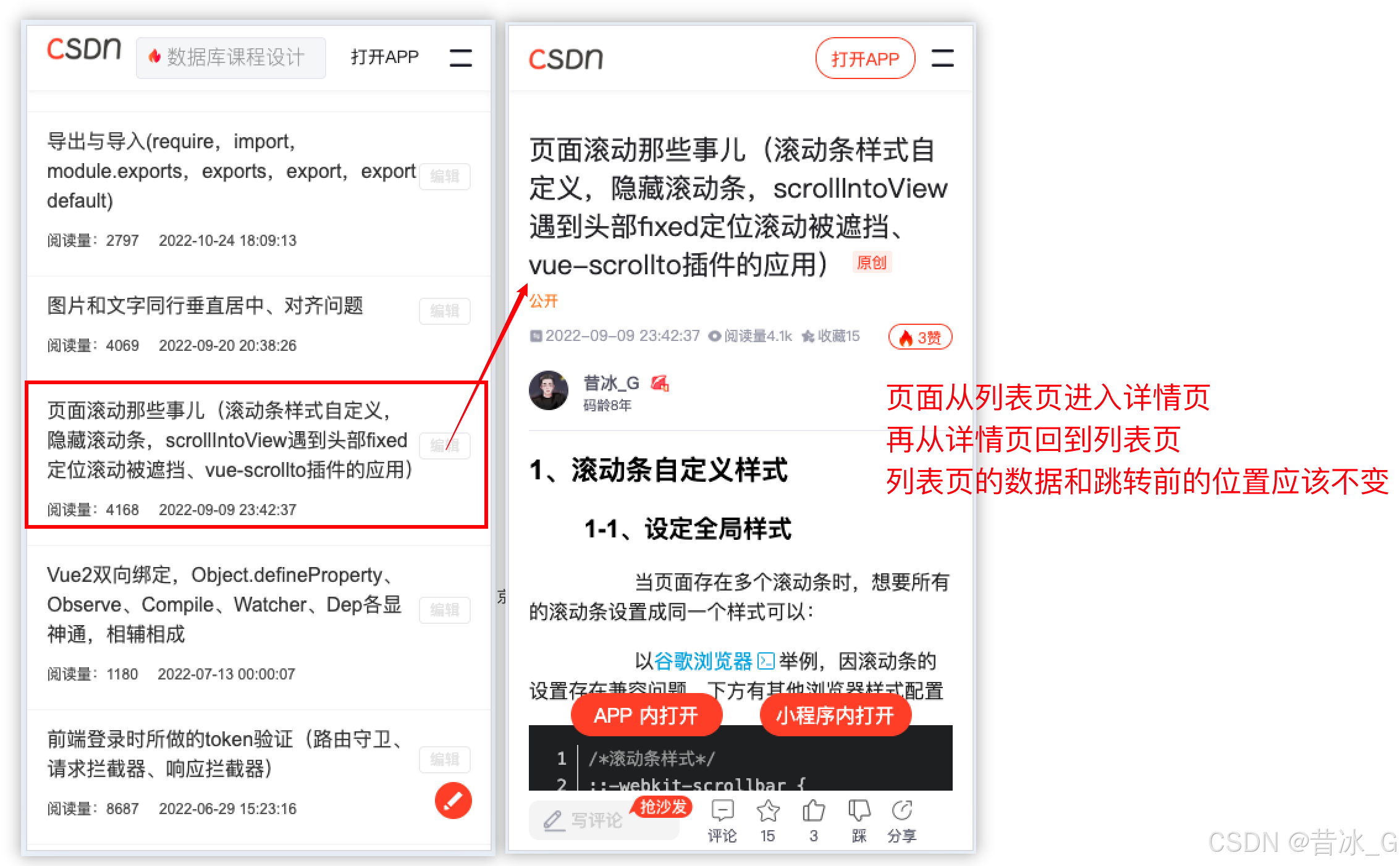Vue内置组件KeepAlive——缓存组件实例
keep-alive 是一个Vue内置组件,它的功能是在多个组件间动态切换时缓存被移除的组件实例,而不是销毁它们。
【注意】这玩意儿可不是Vue3独有的,在Vue2中就已经有了,只不过没有像Vue3那样直接显示在文档首页的侧边栏中。

使用意义
- 性能优化:避免组件重复渲染带来的性能开销
- 状态保持:保留组件状态(数据、滚动位置等)
- 用户体验:实现页面的快速切换,保持用户操作状态
日常场景
- 对于列表页面,点击列表项跳转到详情页面;
- 再从详情页面返回到列表页面:
- 列表页面重新加载?重置了数据?
- 列表页面原数据加载?但页面却回滚到顶部?
- 列表页面保持跳转前的状态,位置不变(这个才是对用户友好的方案)
页面重新加载源于页面从销毁又到呈现的状态切换;
如果可以留存住页面状态或不让页面销毁那页面便不需要重建——使用keep-alive做页面缓存

使用方法
基本用法
<!-- 非活跃的组件将会被缓存! -->
<KeepAlive><component :is="activeComponent" />
</KeepAlive>搭配RouterView当在处理 KeepAlive** **组件时,我们通常想要保持路由组件活跃,而不是 RouterView 本身。为了实现这个目的,我们可以将 KeepAlive 组件放置在插槽内:
<router-view v-slot="{ Component }"><keep-alive><component :is="Component" /></keep-alive>
</router-view>包含和排除
它会根据组件的 name 选项进行匹配,所以组件如果想要条件性地被 KeepAlive 缓存,就必须显式声明一个 name 选项。
在 3.2.34 或以上的版本中,使用 <script setup> 的单文件组件会自动根据文件名生成对应的 name 选项,无需再手动声明。
<!-- 以英文逗号分隔的字符串 -->
<KeepAlive include="a,b"><component :is="view" />
</KeepAlive><!-- 正则表达式 (需使用 v-bind) -->
<KeepAlive :include="/a|b/"><component :is="view" />
</KeepAlive><!-- 数组 (需使用 v-bind) -->
<KeepAlive :include="['a', 'b']"><component :is="view" />
</KeepAlive>搭配路由渲染
import { createRouter, createWebHistory } from 'vue-router'
import List from '../components/list.vue'
const router = createRouter({history: createWebHistory(),routes: [{path: '/',component: () => import('../components/layout.vue'),redirect: '/home',children: [{path: '/home',component: () => import('../components/home.vue')},{path: '/list',// component: List,component: () => import('../components/lista.vue'),// 配置自定义属性keepAlive,在路由加载页面时做条件渲染meta: {keepAlive: true}},{path: '/myinfo',component: () => import('../components/myinfo.vue')},{path: '/iteminfo',component: () => import('../components/iteminfo.vue')}]}]
})
export default router
<!-- Layout.vue --><router-view v-slot="{ Component }"><component :is="Component" :key="route.path" v-if="!route.meta?.keepAlive" /><keep-alive><component :is="Component" :key="route.path" v-if="route.meta?.keepAlive" /></keep-alive>
</router-view>缓存数量
可以通过传入 max 来限制可被缓存的最大组件实例数(组件数量)。
如果缓存的实例数量即将超过指定的那个最大数量,则最久没有被访问的缓存实例将被销毁,以便为新的实例腾出空间。
<KeepAlive :max="10"><component :is="activeComponent" />
</KeepAlive>生命周期
一个持续存在的组件(被Keep-alive缓存的组件)可以通过 onActivated() 和 onDeactivated() 注册相应的两个状态的生命周期钩子:
<script setup>
import { onActivated, onDeactivated } from 'vue'onActivated(() => {// 调用时机为首次挂载// 以及每次从缓存中被重新插入时
})onDeactivated(() => {// 在从 DOM 上移除、进入缓存// 以及组件卸载时调用
})
</script>onActivated在组件挂载时也会调用,并且onDeactivated在组件卸载时也会调用。- 这两个钩子不仅适用于
<KeepAlive>缓存的根组件,也适用于缓存树中的后代组件。
其他
举一反三:
当前的iteminfo页面路由处于layout管辖下,如若将iteminfo路由提至layout同级,怎么完成对list的缓存处理?
要先稳住layout,否则layout保不住,更别提保layout的子路由list了。
import { createRouter, createWebHistory } from 'vue-router'const router = createRouter({history: createWebHistory(import.meta.env.BASE_URL),routes: [{path:'/',component:()=>import('../components/Layout.vue'),redirect:'/home',children:[{path:'/home',component:()=>import('../components/Home.vue')},{path:'/list',component:()=>import('../components/List.vue'),meta:{keepAlive:true}},{path:'/myinfo',component:()=>import('../components/Myinfo.vue')},// {// path:'/iteminfo',// component: () => import('../components/ItemInfo.vue')// }]},// 挪到了外层,和layout同级{path:'/iteminfo',component: () => import('../components/ItemInfo.vue')}],
})export default router
<!-- App.vue -->
<script setup></script><template><router-view v-slot="{ Component }"><!-- 要先稳住layout,否则layout保不住,更别提保layout的子路由list了 --><KeepAlive include="Layout"><component :is="Component" /></KeepAlive></router-view>
</template><style scoped></style>
